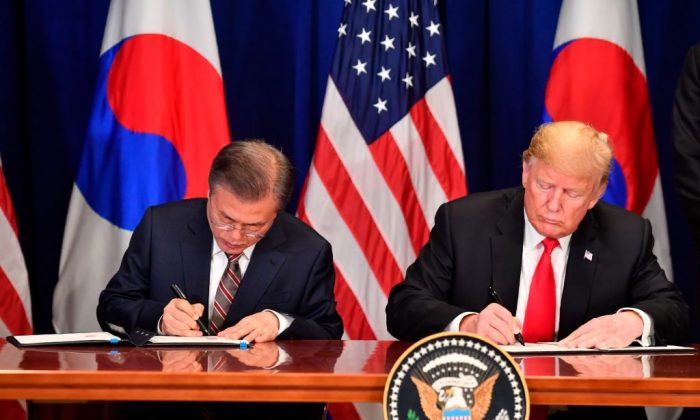The United States and South Korea have signed a revised free-trade deal, which President Donald Trump says includes significant improvements that will reduce the U.S. trade deficit with South Korea and widen opportunities for American exporters.
“It’s a very big deal. This is a great day for the United States and a great day for South Korea,” Trump said on Sept. 24, during the signing ceremony with South Korean President Moon Jae-in at the Lotte New York Palace in New York City.
Speaking at the ceremony, Moon said the amendments and modifications to improve the existing agreement eliminated the uncertainty and expanded the “rock-solid alliance” between both sides.
“Companies from both countries will now be able to do business under more stable conditions,” Moon said.
The new free-trade deal with South Korea, known as the U.S.–Korea Free-Trade Agreement (KORUS), tackles many trade issues faced by U.S. exporters, mainly automotive producers.
Nearly 80 percent of the trade deficit in goods with South Korea is in auto and auto parts; the old agreement had many barriers to U.S. automotive manufacturers. In the new agreement, South Korea makes a number of concessions to the United States on auto exports.
“Many of the provisions focus on autos, which is where the United States has a large trade deficit,” said Troy Stangarone, senior director at Korea Economic Institute of America. “This should, in the years to come, help expand U.S. exports of autos to South Korea. But ultimately this is only going to be a small portion of the overall U.S. trade profile with South Korea.”
According to the new agreement, the United States will continue to impose a 25 percent tariff on pickup truck imports from South Korea for an additional 20 years, instead of three years under the previous trade deal. The tariff on trucks will phase-out by 2041.
South Korea will also increase its annual cap for cars that meet the U.S. safety standards to 50,000 per manufacturer from 25,000. According to Trump, this change will double the export opportunity for each American producer.
In addition, South Korea has agreed to eliminate regulatory barriers for U.S. auto exporters by aligning their environmental testing standards with those of the United States. The Koreans have also agreed to level the playing field for American pharmaceutical exporters.
While automotive has been a big-ticket export item that gets much of the attention, there are other provisions in the agreement that benefit both sides, according to Stangarone.
South Korea had concerns about how the United States runs its trade-discipline policies such as dumping and anti-dumping, he said, adding that the new agreement requires more transparency on the United States’ side.
In addition, the agreement eases rules on how textiles are inspected in South Korea for export to the United States.
The previous deal was initially negotiated in 2007 and went into effect in 2012 during the Obama administration. The Trump administration blamed President Barack Obama for signing an agreement that substantially increased the trade deficit in goods with South Korea. Trump called KORUS “horrible” and asked the U.S. trade representative to renegotiate the terms.
“This is long in coming, many years actually,” said Trump, calling the agreement a historic milestone.
“For decades, politicians have talked about fixing broken trade deals only to do absolutely nothing about them. My administration is the first to actually keep our promise and deliver.”
Steel and Aluminum
The new KORUS also limits steel and aluminum imports from South Korea. According to the agreement, the United States imposes a 10 percent tariff on aluminum imports. Steel, however, will be subject to a quota, rather than a tariff.
The quota on steel will be product-specific, and equivalent to 70 percent of the average annual steel export volume of South Korea in the last three years.
Through this deal, the United States will be able to achieve a 30 percent reduction in steel imports by volume and value, according to the White House.
The United States is the world’s biggest steel-importing nation, buying almost 36 million tons in 2017. South Korea is the third-largest supplier of steel followed by Canada and Brazil.
Although both parties signed the free-trade agreement, there is still a challenge standing in the way, which is the ongoing Section 232 investigation on automotive imports.
In May, Trump directed the Secretary of Commerce to launch a Section 232 investigation into whether imports of automobiles and auto parts threaten to impair national security. The White House is contemplating tariffs as high as 25 percent on auto imports.
“If they move forward and make a determination that the importation of autos in the United States is a national security risk, then we have a question of whether South Korea will get an exemption,” Stangarone said.
If they get an exemption, Korea’s National Assembly will quickly move through and ratify the agreement. Otherwise, the trade deal may face a political challenge in South Korea, he said.


